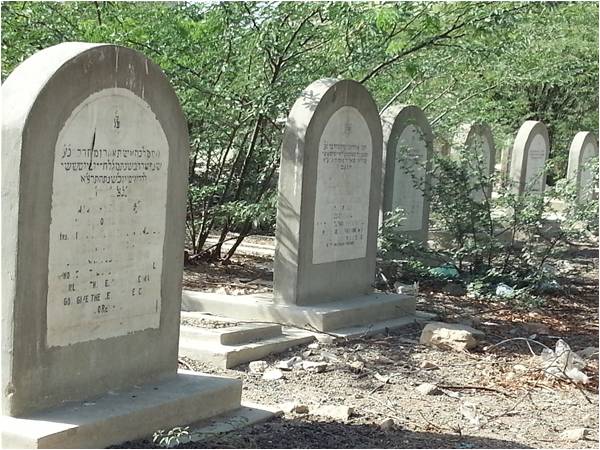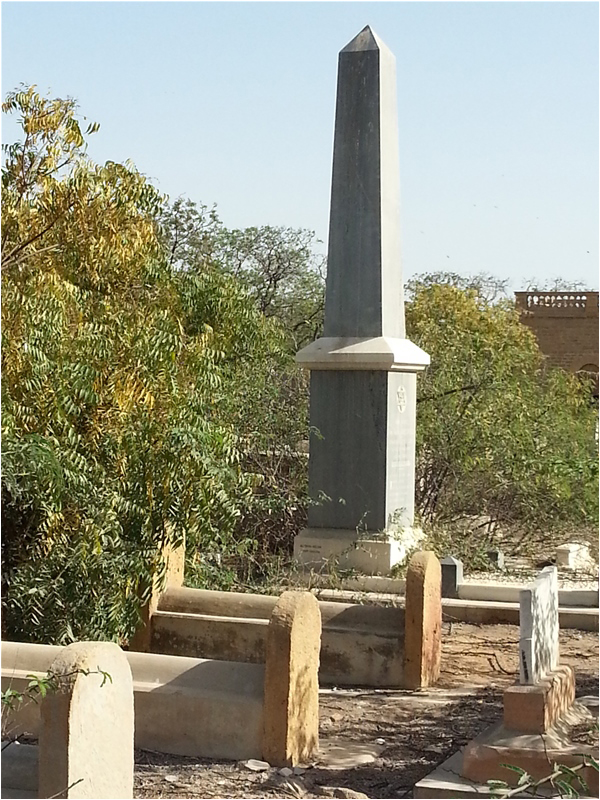
In the Mewa Shah graveyard – one of the oldest cemeteries in Karachi – there is a small compound unknown to most residents of the city. It has 300 Jewish graves.
Mehratun, a woman in her 70s who sells rose petals at the gate of the Muslim graveyard, belongs to a Baloch family that has looked after the compound most of her adult life.
“The Jews used this compound for funerals and last rites,” she said, pointing to the cemetery locally known as Bene Isareli Muqaam. Then she turned back. “This side was Muslim. In the beginning, they were friendly with each other.”
Her father in law was an employee at the Magen Shalome Synagogue in the Rancho Lane locality, locally known as the Bene Israeli Maset. “Mewa Shah was a forest at that time,” she said. Then her husband took at job at the same synagogue. “His job was to give outmeat and sweets on a bicycle, to the Baloch and to other communities in the neighborhood.”
This is not the only Jewish graveyard in the city. Another one is situated in the Nokein Lane area of Lyari, inside a Muslim graveyard near Cheel Chowk, run by the Kutchi Memon Markazi Jamaat, a welfare organization belonging to the Kutchi community. It has been separated from the main cemetery with a boundary wall.
The 85-year-old caretaker of the Jewish graveyard is known as Babu Baloch, although his real name is Mulla Khuda Dad. He says thecemetery is 220 years old, much older than the Jewish cemetery in the in Mewa Shah graveyard. His great great grandfather had served as the caretaker of the cemetery, which originally consisted of about ten acres of land. “But in the 1920s, a local Memon Kutchi businessman, Haji Bachal alias Ladha, purchased the land from the British government and gifted it to his community,” Babu Baloch said. “The Jews of the city had filed a case against the deal in a Bombay court. The case ran on for several years, but they could not get the land back.”
Ties between Muslims and Jews in the local neighborhoods were very good, says Babu. “The Jews were mainly businessmen and administrators, and helped local Muslim communities, mainly Baloch and Kutchis,” he said.
The gravestones in the Nokein Lane cemetery are large and Chowkundi styled and have inscriptions in Hebrew. The oldest grave whose date I could read was from 1836. The gravestones in the Mewa Shah cemetery were made of white marble.
“These crumbling stones can tell us a lot about our history,” says Mehratun’s son, who has grown up in the Jewish graveyard. “We are protecting this past by ourselves, without the government’s help.”

There were 650 Jews living in Karachi in 1919, likely in Ranchor Lane, Lines Area and the Ram Swami locality. Most of them were Bene Israel Jews from Maharashtra, India. Some of them may be from Iraq. Thousands of Jews left their homeland after the siege of Jerusalem by Roman emperor Titus in 70AD. Many went to Iran and Iraq. Some experts say Iraqi Jews came to Karachi during theBritish rule.
By 1947, the number of Jews in Karachi had increased to about 1,500. But many of them left shortly before the creation of Israel in 1948, and most had moved to Israel, India, and Canada.
Yona Rothman, a teacher at the Yeshivat Simchat Shlomo in Jerusalem, says it is likely that some Baghdadi Jews ended up in India in the 1800s, because of business.
“After Bombay, Karachi was second best option for the Jewish businessmen in the sub-continent,” he said. “In Karachi, they played a key role in the development of the city and no one can erase this page of history.”
Gul Hasan Kalmati, a veteran researcher who recently wrote a book on the history of Karachi (Karachi – Sindh jee Marwi) said Jewisharchitects, engineers and educationists had a major contribution in the city’s history.
Solomon David and Omer Daker built the Magen Shalome Synagogue in the Rancho Lane area in 1893. (It was razed in 1988 and was replaced by a shopping plaza).
Abraham Reuben was elected as a member of the Karachi Municipal Corporation in 1919 and served until 1939, Kalmati said. Moses Somak, an architect, made a number of buildings in the city between 1890 and 1910, including the Flag Staff House (now known as the Quaid-e-Azam House).
A number of Jewish people had married Muslims and Parsis, said Usman Baloch, a political leader in Lyari. He said the two Jewishcemeteries should be declared protected sites. “They could be encroached on by land grabbers,” he said, “or extremists could harm the heritage sites because of anti-Israel sentiments.”
The writer is a freelance journalist and researcher
Email: hdilmurad@yahoo.com
Twitter: @hdilmrad
Mehratun, a woman in her 70s who sells rose petals at the gate of the Muslim graveyard, belongs to a Baloch family that has looked after the compound most of her adult life.
“The Jews used this compound for funerals and last rites,” she said, pointing to the cemetery locally known as Bene Isareli Muqaam. Then she turned back. “This side was Muslim. In the beginning, they were friendly with each other.”
Her father in law was an employee at the Magen Shalome Synagogue in the Rancho Lane locality, locally known as the Bene Israeli Maset. “Mewa Shah was a forest at that time,” she said. Then her husband took at job at the same synagogue. “His job was to give outmeat and sweets on a bicycle, to the Baloch and to other communities in the neighborhood.”
By 1947, the number of Jews in Karachi had increased to about 1,500
This is not the only Jewish graveyard in the city. Another one is situated in the Nokein Lane area of Lyari, inside a Muslim graveyard near Cheel Chowk, run by the Kutchi Memon Markazi Jamaat, a welfare organization belonging to the Kutchi community. It has been separated from the main cemetery with a boundary wall.
The 85-year-old caretaker of the Jewish graveyard is known as Babu Baloch, although his real name is Mulla Khuda Dad. He says thecemetery is 220 years old, much older than the Jewish cemetery in the in Mewa Shah graveyard. His great great grandfather had served as the caretaker of the cemetery, which originally consisted of about ten acres of land. “But in the 1920s, a local Memon Kutchi businessman, Haji Bachal alias Ladha, purchased the land from the British government and gifted it to his community,” Babu Baloch said. “The Jews of the city had filed a case against the deal in a Bombay court. The case ran on for several years, but they could not get the land back.”
Ties between Muslims and Jews in the local neighborhoods were very good, says Babu. “The Jews were mainly businessmen and administrators, and helped local Muslim communities, mainly Baloch and Kutchis,” he said.
The gravestones in the Nokein Lane cemetery are large and Chowkundi styled and have inscriptions in Hebrew. The oldest grave whose date I could read was from 1836. The gravestones in the Mewa Shah cemetery were made of white marble.
“These crumbling stones can tell us a lot about our history,” says Mehratun’s son, who has grown up in the Jewish graveyard. “We are protecting this past by ourselves, without the government’s help.”

There were 650 Jews living in Karachi in 1919, likely in Ranchor Lane, Lines Area and the Ram Swami locality. Most of them were Bene Israel Jews from Maharashtra, India. Some of them may be from Iraq. Thousands of Jews left their homeland after the siege of Jerusalem by Roman emperor Titus in 70AD. Many went to Iran and Iraq. Some experts say Iraqi Jews came to Karachi during theBritish rule.
By 1947, the number of Jews in Karachi had increased to about 1,500. But many of them left shortly before the creation of Israel in 1948, and most had moved to Israel, India, and Canada.
Yona Rothman, a teacher at the Yeshivat Simchat Shlomo in Jerusalem, says it is likely that some Baghdadi Jews ended up in India in the 1800s, because of business.
“After Bombay, Karachi was second best option for the Jewish businessmen in the sub-continent,” he said. “In Karachi, they played a key role in the development of the city and no one can erase this page of history.”
Gul Hasan Kalmati, a veteran researcher who recently wrote a book on the history of Karachi (Karachi – Sindh jee Marwi) said Jewisharchitects, engineers and educationists had a major contribution in the city’s history.
Solomon David and Omer Daker built the Magen Shalome Synagogue in the Rancho Lane area in 1893. (It was razed in 1988 and was replaced by a shopping plaza).
Abraham Reuben was elected as a member of the Karachi Municipal Corporation in 1919 and served until 1939, Kalmati said. Moses Somak, an architect, made a number of buildings in the city between 1890 and 1910, including the Flag Staff House (now known as the Quaid-e-Azam House).
A number of Jewish people had married Muslims and Parsis, said Usman Baloch, a political leader in Lyari. He said the two Jewishcemeteries should be declared protected sites. “They could be encroached on by land grabbers,” he said, “or extremists could harm the heritage sites because of anti-Israel sentiments.”
The writer is a freelance journalist and researcher
Email: hdilmurad@yahoo.com
Twitter: @hdilmrad

